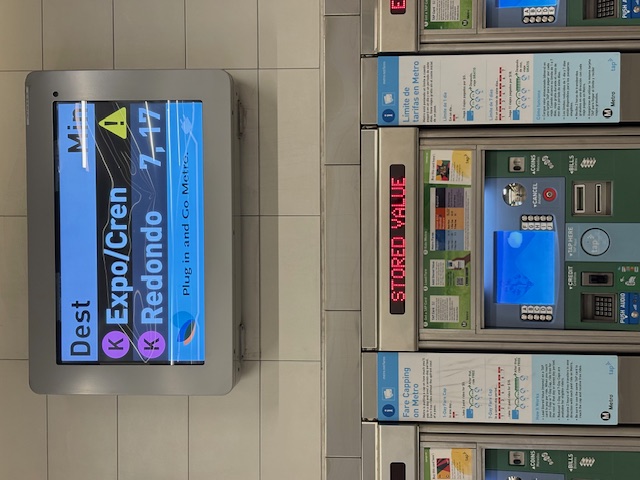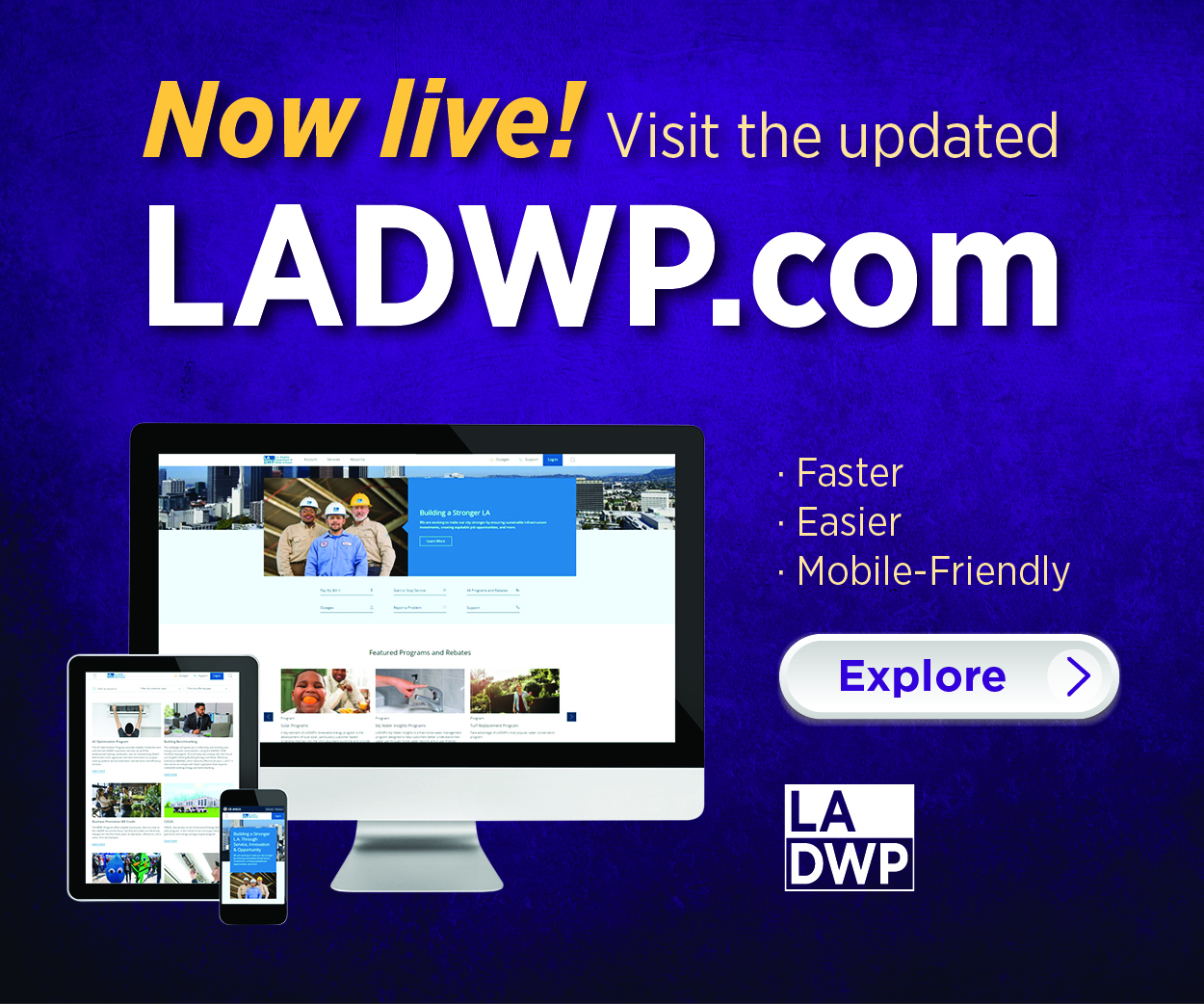Comments
LA TRANSPO - The opening of the LAX Transit center moves Los Angeles closer to a more integrated transit system by finally get travelers close to the airport via light rail and city bus. It is frustrating that in moving people to and from LAX by light rail train or city bus, LAWA/LAX and Metro have missed the mark, or the runway, or the bus or train stop.
My transit routine now involves regularly riding the K/Crenshaw Line to the LAX Transit Center to transfer to a city bus. I am experiencing a lack of clear communications on how this new transit center works.

The building itself is large, gratefully airy, welcoming on its own, with sun light streaming in. It is a welcome addition to the city’s historic and remarkable architecture, and the transit center compliments the very famous LAX control tower and Theme Building.
But as I become more acquainted with the LAX Transit Center, signage issues arise, and throw confusion towards transit riders.
For Crenshaw Line riders who disembark from the train at the LAX Transit Center, there is a lack of easy to read and understandable signage.
At the transit center we leave the train at ground level, and find our only option is to take stairs, an elevator or escalator to the second level with the options to continue to an LAX Shuttle, or transfer to a city bus. I had to ask a Metro Ambassador during my first trip to the LAX Transit Center where to go.
After taking the escalator from the ground floor to the second floor, we pass through the fare collectors gates with plexiglass doors for security, and then for city buses take either another set of stairs, elevator or escalator to descend to the ground level for the city bus needed.
As the transit rider descends the escalator to get to the ground floor where the city buses have stops, we see a long awning, columns supporting the awning, a long concrete pad, and numbers for each city bus stop attached to the columns. The numbers for each city bus stop are clearly visible. But, when descending the escalator, there is no indication which numbered stop is for which specific city bus. We should be able to see from a distance, at first glance, as clearly as we see the numbers, which city bus stops where.
It is not until the transit rider is on foot walking toward the numbered bus stops that we first see one stainless steel, square kiosk with two screens, the bottom for transit information and the top for which city bus stops there. Until walking directly up to the kiosks, they are blocked from view by the supporting columns. They are basically invisible.
Even after the approaching the kiosks and standing within a foot or two there is still confusion. All of the kiosks at all of the city bus stops at the LAX Transit Center have very dim screens. In the bright sun, with a strong glare, they are very difficult to read. There are at many stops, and if the transit rider needs, for example, stop number eight, they need to walk up very close to each kiosk, and try to read the kiosk for city bus stop eight.
The transit rider, either from a bus, train or jet, when descending the escalator or stairs to the city bus stops should be able to easily read which city bus stops at which numbered stop. On each support column, underneath the signs with numbers there needs to be a hard copy, analog, preferably metal, large signs of which bus stops at which number.
The signs should be in the color used by the different bus agencies, such as green for Culver City Bus; blue for Big Blue Santa Monica Bus, orange for Metro, and so forth.
This would give transit riders quick identification. But now we need to walk up to each kiosk for city bus identification. In addition to greater clarity in signage, the analog city bus signs would have been vastly cheaper than the stainless steel kiosks with two monitors and the electricity needed to power the screens. Hanging signs would also be more environmentally sensitive because those kiosk monitors will burn out, and will need to be properly recycled, and replaced.
The kiosks do not serve transit rider for a quick identification of which bus stop is where, and at a transit center time is of the essence to catch the next city bus which may be needed for a transfer.
It seems the LAX Transit Center designers, architects, engineers, planners became so enamored with the design, the idea of function that assists transit riders was shortchanged.
The other day while walking towards the city bus stop I needed at the LAX Transit Center, a man carrying a large travel bag ran towards the end of the bus stops, then ran back towards the escalators. He spotted two Metro Ambassadors who hopefully assisted this frantic man trying to get somewhere. He then ran back to some place in the center. I could imagine he was lost, confused, confounded, and anxiety ridden, trying desperately to get his flight but was delayed because of the lack of clear, easy to read, concise signage.
This current configuration of signage at the city bus stops is a disservice to transit riders, is a waste of tax money, and only continues to give poor ratings to LAX and Metro.
The Metro Expo/Crenshaw Station, prelude to confusion
For the past six months the Crenshaw Line has been part of my regulars transit commute, with transfers between the Expo Line at the Expo/Crenshaw Station. Until the opening of the LAX Transit Center June 6, 2025, the Crenshaw Line was little used. It was like my own railroad (of course it’s light rail), with few riders along for the ride. Now, foot traffic has greatly increased, and that is fantastic. Train cars are more crowded, but they do not approach the ridership of the Expo Line which in commuter hours is standing room. The Crenshaw Line may increase ridership even more, but to get repeat customers, the signage needs an overhaul.
At the Expo/Crenshaw there are more riders with luggage, with LAX luggage tags, coming from the airport.
I also see an increase of riders transferring from Expo to Crenshaw Lines, and this direction of travel is where I see confusion and anxiety from other riders. It’s on their faces, it’s in their eyes.
This signage confusion at the Expo/Crenshaw Station gives a preview of the signage confusion at the LAX Transit Center.
At this station street level the transit rider descends to the concourse by either escalator, stairs or elevators, and then to the station platform below it is either escalator or stairs. The Crenshaw Line heads south, with the final destination Redondo Beach. (More on that later.)
As the LAX bound transit rider descends from the concourse to the platform, there is one sign to greet them, “Redondo Beach.” Period. There is nothing else. There is no above ground level sign which lists “LAX,” and there must be because this station should become a cornerstone to taking transit riders to LAX.
On the Crenshaw Line trains the electronic marquees do not list “LAX.”
I see riders with luggage stuck on the Crenshaw Line platform, searching for assurance that they are in the right station, and the train in front of them will take them to LAX. I assist them when the Metro Ambassadors are not on the platform, and lately they have not been there. They may have been moved to the LAX Transit Center to assist all of those confused transit riders there.
Every station along the Crenshaw Line can feed the LAX Transit Center Connection transfer, but with a pivotal transfer from the Expo Line, the Expo/Crenshaw Station is crucial to making this a successful transit line, and crucial to the success of the LAX Transit Center.
A transit rider who wishes to get to LAX through this station expects clear signage and that they are heading in the right direction. But Metro gives them no reassurances at all, only signs which state “Redondo Beach.”
I am not a train expert who knows the rules and standards for trains, but I am regular transit rider who, like the rest of the world, expect clear and concise signage such as this station which serves trains which will take them to LAX.
When a person is in unfamiliar surroundings, like standing on the platform of a new to them train station, evolutionary awareness has us look up to scan the horizon to see the terrain, to see if those animals are friendly or will eat us, or if that person, or those people, are friends or foe. Our basic instinct is to look up, not look down at the decals on the platform which has an icon and LAX.
The similar unsuccessful theme at the LAX Transit Center with decals on the floor is used at the Expo/Crenshaw Station, without apparent success.
It cannot be that difficult to create signs at this station with “‘LAX,” or “LAX/Redondo Beach,” to give assurances to those new to the Metro network that they are in the right train station. It should not be that difficult to program the electronic signs on the train cars to simply include “LAX.”
This is just another failure in communications, and leads to questions:
1. Is this just an uncaring cultural attitude at Metro and LAWA/LAX that building the transit system and stations and centers is enough, that doing just the most basic is sufficient?
2. Is there in these organizations a general lack of foresight on how this train and its stations will be used. Surely, there must have been discussions and meetings on who would be using these stations, and the needs of the riders, such as giving assurances that they are in the correct station, and will board the correct train to get to LAX.
3. Are decisions made in closed loops of transit experts, engineers, city and county leaders who know the interior workings and plannings for the transit network, and mistakenly assume everyone who will ride the transit network will have the same level of experience and knowledge, when we transit riders do not.
4. What are the oversights from county and city governments on planning and building these rail networks and stations? What input and insight do they receive from regular transit riders on what does, and doesn’t work?
There has been years of work on how the Crenshaw Line, its stations and LAX Transit Center would operate, and it seems no one thought of the transit rider. It seems no one cares about the transit rider experiences, and whether the operations, and signage, help transit rider, or create anxiety and doubt.
The destination signs at the Crenshaw Line stations and trains’ headings, using only“Redondo Beach,” is strange. Perhaps state and federal regulations require the first and last stations displayed, again, I am not a systems operations expert, but an expert at riding Metro’s trains.
Using “Redondo Beach” is a completely false statement. This station, the end of the line, is miles from the beach. It is in the middle of an industrial park, with close by barren, dry fields, and within shouting distance of the 405 as it winds through the South Bay Curve. It is one of the loneliest and most desolate stations on the Metro rail network. To show honesty, the signs should read “North Redondo Beach,” to not confuse riders, and disappoint those who rightfully thought the train would take them to the beach.
Perhaps asking from Metro and LAWA/LAX for clarity in signage with foresights on how the transit signs affect riders, if they are useful or more of an in-house design, if they serve not only the basic functions but are also a step above to create a non-angst transit experience, is asking for too much.
The opening of the LAX Transit Center, and its lack of clear, concise, helpful signage for transit riders is more than a disappointment, with all of the years of planning, it is a failure. The future of getting vehicles out of LAX and have people instead use Metro and the LAX Transit Center is far off course.
(Matthew Hetz is a Los Angeles native, a composer whose works have been performed nationally, and some can be found here. He is the past President of the Culver City Symphony Orchestra and Marina del Rey Symphony. His dedication to transit issues is to help improve the transit riding experience for all, and to convince drivers to ride buses and trains to fight air pollution and global warming. He is an instructor at Emeritus/Santa Monica College and a regular contributor to CityWatchLA.)

















